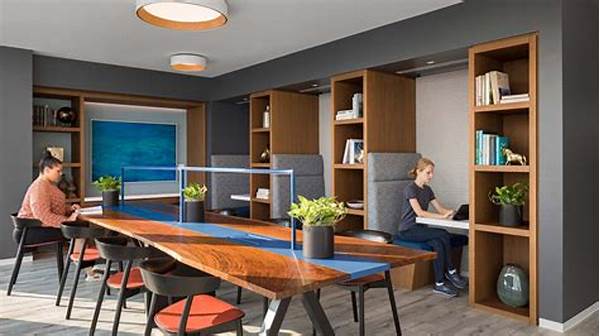In today’s fast-paced, digitally disrupted world, finding the time and space to concentrate deeply is becoming increasingly challenging. The modern work environment, characterized by open floor plans, constant notifications, and collaborative spaces, often prioritizes connectivity over concentration. Enter the deep work-friendly workspace: a novel approach that reimagines the office ethos to place focus and efficiency at the forefront. These spaces cater to the modern worker’s desire to minimize distraction and maximize productivity, embodying both simplicity and sophistication. But what exactly is behind the rise of deep work-friendly workspaces, and why are businesses around the globe adopting this trend with such fervor?
Read More : Deep Work By Cal Newport Pdf
Imagine stepping into an office where focus is not just a concept but a foundational principle. This environment is meticulously designed with productivity in mind, featuring soundproof rooms, comfortable layouts, and a lack of digital interruptions. Here, the ethos revolves around the individual worker’s needs for solitude and concentration without compromising on innovation and creativity. The rise of deep work-friendly workspaces represents a shift from traditional office settings, where distractions are the norm, to more refined spaces encouraging deep cognitive work. These new-age workspaces are supported by research highlighting the adverse impacts of multitasking and the difficulty of regaining focus once interrupted.
The enthusiasm for adopting deep work-friendly workspaces stems from their proven benefits. Companies embracing these designs report not just increased productivity but also enhanced job satisfaction and employee well-being. For businesses and employees alike, the appeal lies in creating an environment where potential can be fully realized without unnecessary distractions. This transition reflects an understanding that workspaces should enable, not hinder, the workforce’s capabilities. Having a refined space to think deeply and freely is increasingly seen as a cornerstone of business success.
Why Deep Work-Friendly Workspaces Matter
Efforts to enhance workplace productivity have evolved significantly, demanding solutions that go beyond bean bags and coffee machines. As the business landscape shifts towards prioritizing mental well-being, the rise of deep work-friendly workspaces underscores a deeper commitment to employee satisfaction and efficiency.
—
Detailed Description of The Rise of Deep Work-Friendly Workspaces
The transformation of offices to accommodate deep work marks a significant sea-change in workplace strategy. Rather than simply providing a place to sit at a desk, employers are now focusing on creating environments that actively support the mental processes of their workforce.
The central philosophy behind deep work-friendly spaces is reducing interruptions which can significantly decrease the time needed to complete tasks. Open offices, while aimed at fostering a collaborative spirit, often inadvertently reduce productivity. The rise of deep work-friendly workspaces seeks to mitigate these problems by introducing controlled spaces designed around concentration and process flow. One particular driver of this trend is the surge in research supporting the detrimental effects of constant distractions, emphasizing the liberation that comes with uninterrupted periods of work.
Elements of Deep Work-Friendly Workspaces
Now, let’s delve into what specifically characterizes these innovative spaces. Features often include designated quiet zones, minimalist design aesthetics, and technology policies that limit intrusive notifications. Additionally, flexible scheduling and remote work options are encouraged, allowing employees to choose their most productive times and spaces.
Moving beyond aesthetics, the strategy behind these workspaces encompasses an understanding of cognitive function. Controlled studies suggest that every interruption drags a person’s focus away, requiring on average 23 minutes to return to the original task. Recognizing this, companies are more compelled than ever to facilitate environments where people can work at their peak cognitive abilities.
The Business Impact of Deep Work-Friendly Workspaces
From a commercial viewpoint, the move towards deep work-friendly environments is not just progressive but necessary. The ROI on such spaces is realized through enhanced output quality, employee retention, and recruitment allure. A space promoting deep work becomes a strategic asset that differentiates a company from its competitors.
For potential employees, the prospect of working in such a conducive environment not only heightens interest but also aligns with personal career aspirations. Employees gain more autonomy over their work pace, indirectly promoting a healthier work-life balance. The impact isn’t unilateral; companies, too, notice improved team morale and a cultural shift towards prioritizing mission-critical tasks.
Although the transition demands an initial investment in design and technology, the tangible benefits far outweigh these costs. Recognizing the value of the rise of deep work-friendly workspaces positions a company as a visionary leader prepared to meet the demands of a dynamic work environment.
—
Key Takeaways About The Rise of Deep Work-Friendly Workspaces
Discussion on The Rise of Deep Work-Friendly Workspaces
The modern employee environment demands not just a place to complete tasks but a nurturing space for ideas to flourish; cue the rise of deep work-friendly workspaces, a design revolution driven by necessity in a digitally pervasive era.
The background noise of traditional office spaces often hinders the quality and speed of project completion. However, as businesses realize the pivotal role of focus-fueled environments, we see the subtle yet powerful pivot toward designing offices that are truly work-positive. These spaces not only valorize distraction-free time but elevate it to a premium offering in organizational culture.
As we probe deeper into the phenomena, data-driven insights propel this movement; consulting firms and researchers have found a positive correlation between dedicated ‘deep work’ zones and output quality. It’s a cultural shift that’s as scientific as it is strategic, placing a critically high value on quality over quantity.
Such spaces promise not an escape but a bridge to realizing fuller, more exacting work potential. Today’s workplaces are learning to embrace change that both nurtures employees’ mental processes and aligns with the competitive needs of the corporate arena. By confirming the merit behind creating environments that empower workers, the rise of deep work-friendly workspaces offers a model for the future of efficient and compassionate workplace design.


